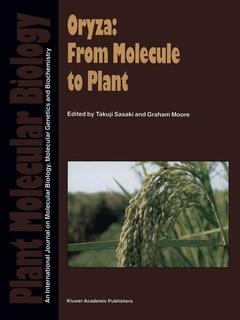Description
Oryza: From Molecule to Plant, Softcover reprint of the original 1st ed. 1997
Coordinators: Sasaki Takuji, Moore Graham
Language: English
Subject for Oryza: From Molecule to Plant:
Keywords
Contig; Moore; agrobacterium; breeding; chromosome; conservation; development; gene; genes; genome; phenotype; plant; rice; sequencing; structure
Publication date: 10-2013
254 p. · 21x28 cm · Paperback
254 p. · 21x28 cm · Paperback
Description
/li>Contents
/li>Comment
/li>
Recent studies have shown that despite gross differences in genome size, the gene order in the cereal genomes has remained remarkably similar. This observation implies that the small genome of rice will reflect the basic structure of the cereal genomes. Rice will therefore become an important tool for all cereal geneticists/molecular biologists as information generated by rice breeders/geneticists/molecular biologists becomes combined in databases with that generated by researchers studying other cereals. Rice research will therefore be of interest to all cereal breeders/geneticists/molecular biologists. This Edition reviews the current state of knowledge of its genome, genes, germplasm collections, trait analysis, breeding systems, mutator systems, transformation and diseases.
Comparative genetics in the grasses.- Are rice chromosomes components of a holocentric chromosome ancestor?.- Origin, dispersal, cultivation and variation of rice.- Alien introgression in rice.- Linkage map of phenotype and RFLP markers in rice.- Conservation of rice genetic resources: the role of the International Rice Genebank at IRRI.- Rice genetic resources: history, conservation, investigative characterization and uze in Japan.- Rice molecular genetic map using RFLPs and its applications.- Microsatellite marker development, mapping and applications in rice genetics and breeding.- Physical mapping of the rice genome with YAC clones.- Physical mapping of the rice genome with BACs.- A rapid and accurate strategy for rice contig map construction by combination of fingerprinting and hybridization.- Large-scale EST sequencing in rice.- Genetic and molecular dissection of quantitative traits in rice.- QTL analysis to study the association between leaf size and abscisic acid accumulation in droughted rice leaves and comparisons across cereals.- Comparative genetics of flowering time.- The molecular basis of disease resistance in rice.- Towards map-based cloning of the barley stem rust resistance genes Rpg1 and rpg4 using rice as an intergenomic cloning vehicle.- Rice transformation: bombardment.- Transformation of rice mediated by Agrobacterium tumefaciens.- Transposon tagging in rice.- Retrotransposons of rice: their regulation and use for genome analysis.- Public informatics resources for rice and other grasses.
Recent studies have shown that despite gross differences in genome size, the gene order in the cereal genomes has remained remarkably similar. This observation implies that the small genome of rice will reflect the basic structure of the cereal genomes. Rice will therefore become an important tool for all cereal geneticists/molecular biologists as information generated by rice breeders/geneticists/molecular biologists becomes combined in databases with that generated by researchers studying other cereals. Rice research will therefore be of interest to all cereal breeders/geneticists/molecular biologists. This Edition reviews the current state of knowledge of its genome, genes, germplasm collections, trait analysis, breeding systems, mutator systems, transformation and diseases.
© 2024 LAVOISIER S.A.S.




